Tang Garden is a beautiful tile placement game in which one to four players compete to build and decorate a communal garden during the Tang Dynasty in the sixth century (considered China’s first golden age of arts and culture). When building the garden, you’ll have to balance water, rock, and greenery tiles and decorate it with pavilions, bridges, trees, flowers, birds, and fish. Over the course of the game, characters will visit the garden to inspect its progress and admire the surrounding landscape. Players do all of this in hopes of earning the most coins, which are the “points” in the game.
Hey! I’m Smash. Nice to see you again. Join us as we delve deeper into Tang Garden’s multiplayer and solo gameplay.
Check out our video review of Tang Garden.
Tang Garden Gameplay
On a player’s turn, they’ll perform one main action and possibly three optional actions. Players, in turn order, take turns in this way until the end game is triggered.
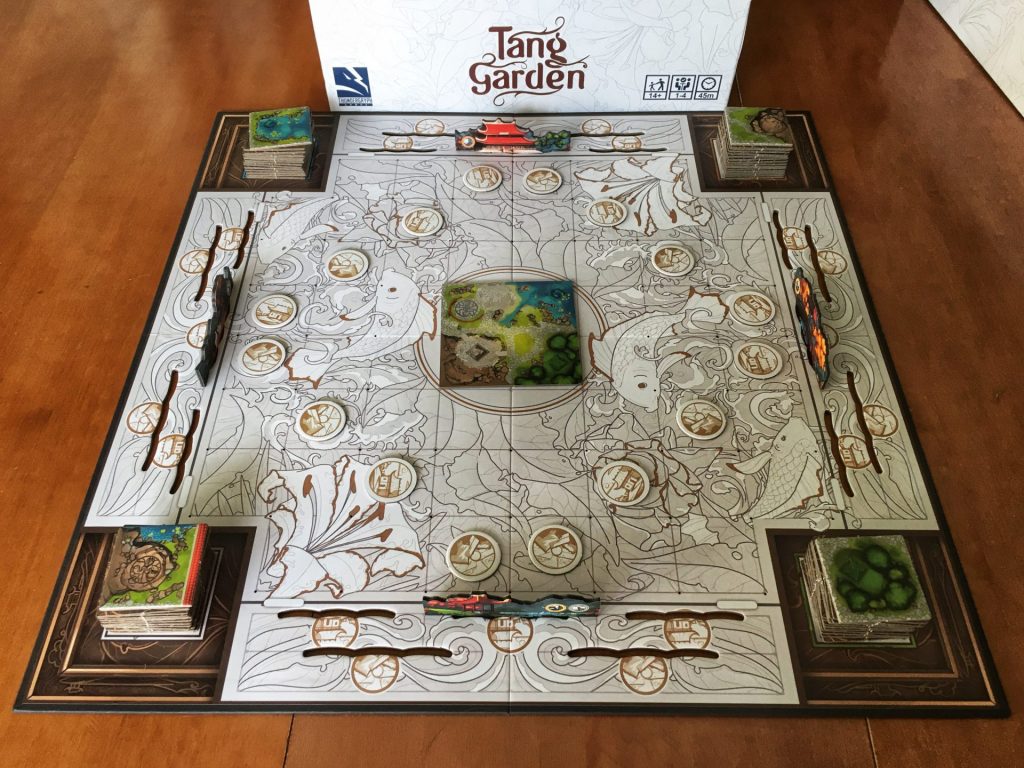
Main Actions
Players have one of two mandatory main actions to choose from: Build the Garden or Place a Decoration.
Build the Garden
To Build the Garden, choose one of the faceup Garden tiles and place it on the board following these placement rules:
- must be placed orthogonally adjacent to a tile already on the board
- the terrain type must match the edges of adjacent tiles (similar to placing tiles in Carcassonne)
Some tiles feature a red wall along one edge. These walls are the exception to this last placement rule because they’re considered to match any terrain type.

After placing your tile, move the corresponding markers on your player board one space forward for each terrain edge you matched to adjacent tiles.

Then, if the placed tile causes an area to be completely enclosed, advance the marker matching the enclosed terrain one step. (In the picture above, the player enclosed the rock area so they would move the yellow marker one additional space forward.)
Walls may be used to enclose an area — in fact they’re an excellent way to do so.
There are also gray footpaths, which you might have noticed aren’t represented on the player board. If you match one footpath edge, gain a coin — remember coins are how you win. However, if you match two footpath edges, you have a decision to make: gain two coins or advance the marker of your choice one space.
It will become clear soon why you want to balance your movement on these three player board tracks, but suffice it to say the two footpath advancement bonus can be incredibly helpful (and powerful).
Additionally, if the tile you placed covers up a Landscape token, you must insert one of the two available Landscape tiles into the board. Landscape tiles come in two sizes: small (depicted by the house) and large (shown by the mountain).
Landscape tiles aren’t simply board embellishments (although that is an added bonus); they are incredibly important for scoring the Characters who visit your garden.

After completing the Build the Garden action, if there is one or no tiles faceup, flip the top tile of each stack so there are four visible Garden tiles. If there is more than one, do nothing.
Place a Decoration
The other main action, that has a bit of a set collection element to it, is to Place a Decoration onto a tile in the garden. To do this draw two Decoration cards plus one for each facedown Garden tile, then choose one card to play and discard the others.

When choosing which Decoration card to keep, you first need to consider whether you can legally place the decoration in the garden. For example, if you want to play a Fish card, there must be an available tile (one that doesn’t have a decoration already) with water on it. You also want to think about its one-time bonus; sometimes this is a marker advancement and occasionally it’s Landscape tokens. Then you need to consider the end game scoring opportunity. For example, would you like to work towards collecting pairs of Fish and Birds, different types of Trees, or the most Pavilions?
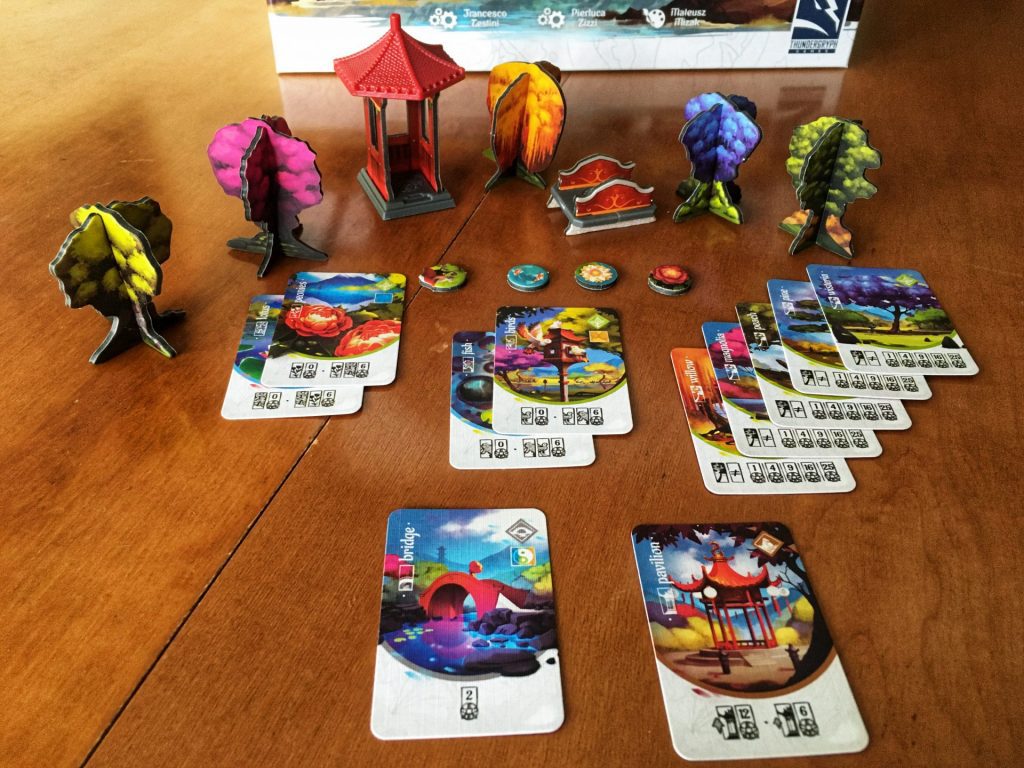
There is a lot to consider when selecting which Decoration card to play…and there is even more to ponder when placing the decoration into the garden.
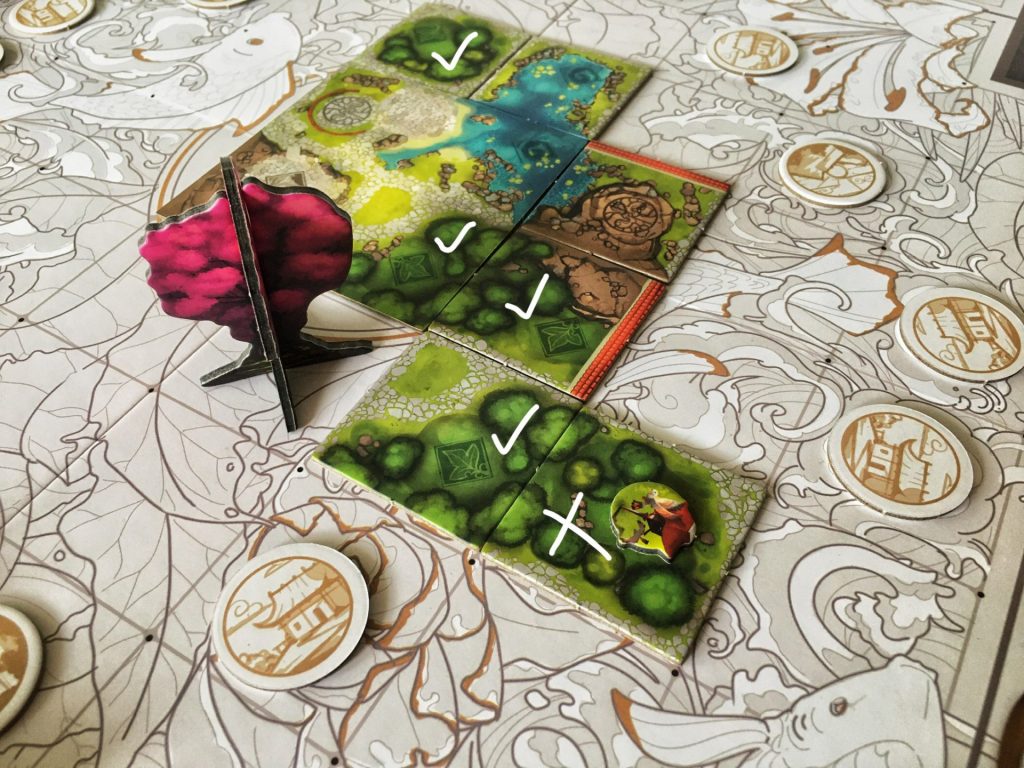
Looking at the picture above, it might seem like decoration placement doesn’t matter, but that changes once Characters enter the garden. Your Characters like to look at pretty things — but so do the Characters of your opponents.
Finally, after choosing and placing a decoration, flip all facedown Garden tiles faceup.
Have you gotten a sense yet of how much Tang Garden is a delicate balancing act? No? Well let’s add the Characters to the mix.
Optional Actions
Once you’ve performed your main action, you may do the following optional actions:
- Influence a Character
- Use a Lantern
- Refresh a Lantern
First, let’s look at how to Influence a Character — at long last. Players start the game with a Character (card and miniature) who gives them a special ability, but as the markers move ahead on their player boards, they have the opportunity to influence more Characters and send some to the garden to activate their end game scoring ability.

Once you are able to Influence a Character, choose from one of the two faceup Character cards or draw off the top of the deck. Then play one of your Character miniatures to the garden board — either the newly acquired Character or the one you already had by your player board. Characters — like Fish, Trees, Bridges, etc. — are particular about where they’re placed and can only go on a Character spot.
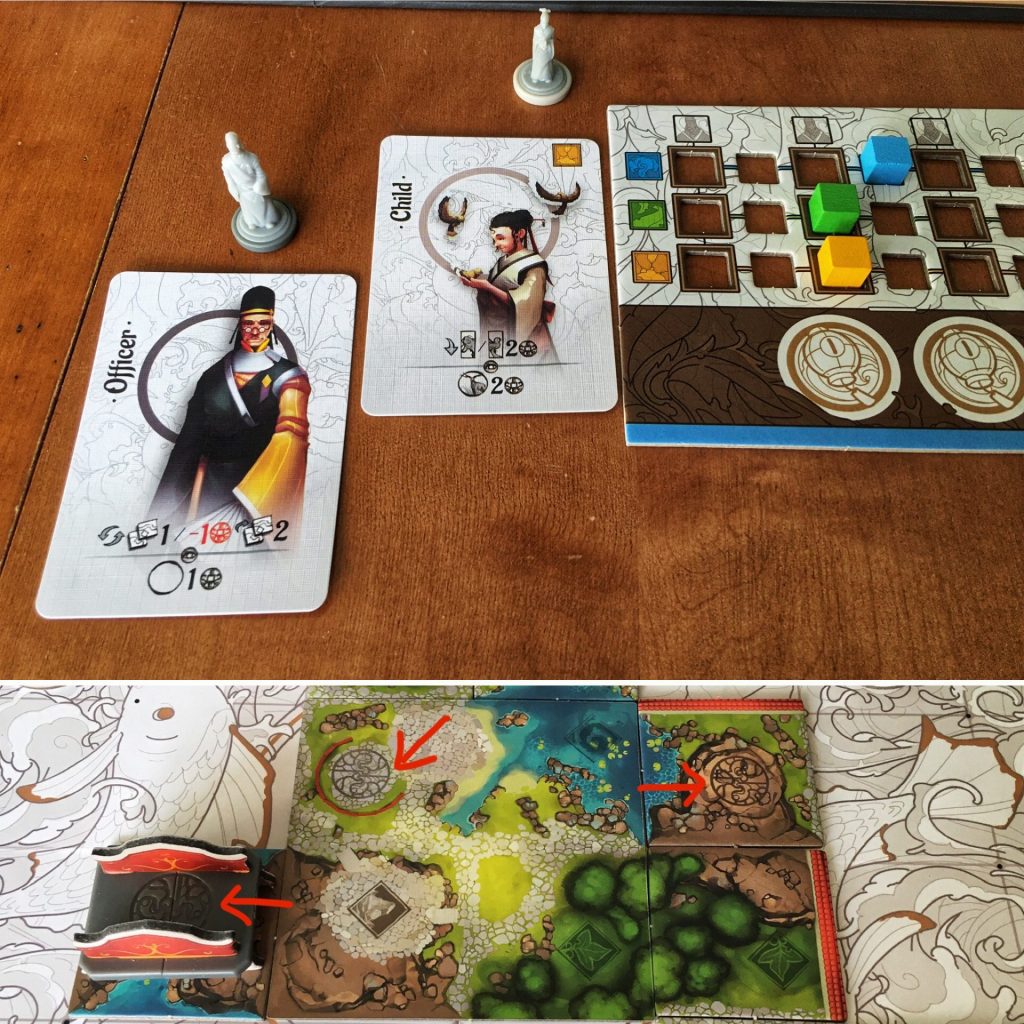
Then you’ll choose a direction for your Character to face (up, down, left, right, or board game North, South, East, and West if you prefer cardinal directions). Just like they’re picky about where they’re placed, they’re also particular about what they look at; any decoration is fine (and earns coins at the end of the game), but not necessarily any landscape. The Character you send to the garden will have some kind of “sight preference” and if you want coins at the end of the game, you’d better do as they please.
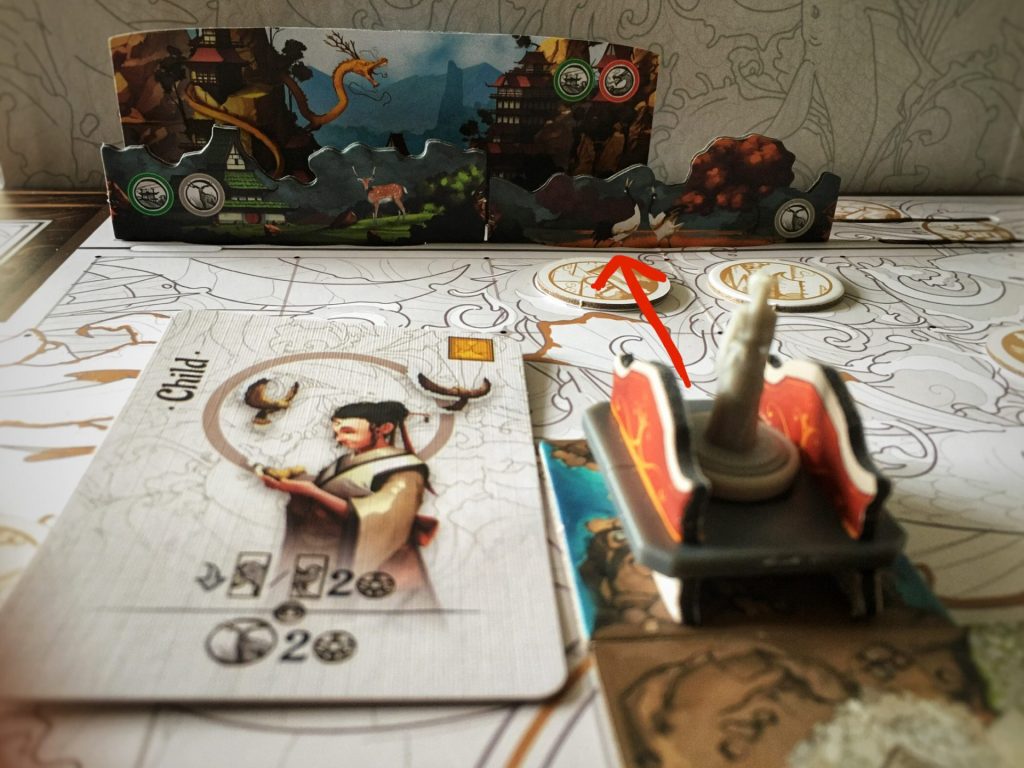
Generally Characters score for icons on Landscape tiles, but a few score for specific terrain tiles (water, rock, greenery) in their line of sight.
Another optional action a player may take on their turn is to Use a Lantern. Each player has four different Lantern tokens and these Lanterns give players a special ability — place two Garden tiles, place two decorations, move a Character, or Influence a specific Character/choose a specific Landscape tile. Only one Lantern can be used per turn and once it is, it’s flipped facedown.
This brings us to the final optional action, Refresh a Lantern. Spend three Landscape tokens you’ve collected during the game to flip a spent Lantern back to its usable side.
End Game and Scoring
The end game is triggered when one of the four Garden tile stacks is depleted or there are three or fewer Landscape tokens on the board; at which point play continues until each player has an equal number of turns. Then players earn coins for their Decoration cards and from their Characters in the garden (both the decorations they see and their final scoring condition).

The goal of the solo game is twofold: first fill the 28 designated spaces of the board with Garden tiles and second, if you don’t lose before this, earn coins and determine how well you did. In the solo game, Decoration cards aren’t collected, Character abilities aren’t active, player boards aren’t used, and there are four special Lantern tokens used.
Initially the solo game sounded like a snoozefest without many of the multiplayer game’s elements. Spoiler…it’s not!
The solo game ends in defeat when there are no legal moves available or one of the Garden tile stacks is depleted and you can’t continue the game by using a Lantern. You win if you place tiles on all 28 central spaces of the board.
Tang Garden Solo Gameplay
The main action in the solo game is a combination of the Build the Garden and Place a Decoration actions. You see each Garden tile stack has a randomly drawn Decoration card associated with it so for every action you take, you’ll be placing a pair into the garden — a tile and a decoration. Both tiles and decorations must follow the game’s usual placement rules and if you cannot, then you can’t choose that tile/decoration pair.

The solo game starts to evolve into a real puzzle because after you’ve chosen and placed your tile and decoration, the pair in the opposite corner of the one you’ve chosen is removed — the card goes to a discard pile while the tile goes to a new area called the “Garden tile display.”
The tiles aren’t discarded in the same way as the cards because there is a Lantern that lets you place a tile from the Garden tile display.
Unlike the multiplayer game, cards and tiles are replenished after each action so you always have four options.
There are other minor rule modifications in the solo game to simulate the tension and experience of a multiplayer game without having to worry about controlling a bot player. For instance, when you Influence a Character, a neutral Character is also placed on the board (to occupy a space) or when you place a Landscape tile, another is placed on the opposite side of where you placed yours.
This isn’t a comprehensive How to Play Tang Garden solo, but hopefully it is enough to give you a sense of the gameplay.
Garden for One – Brief Thoughts
I was quite pleasantly surprised by the solo game experience; I wasn’t sure how the designers could replicate the natural tension and struggle to balance your tile and decoration placements, especially when so many key elements of Tang Garden are removed from the solo gameplay. The solo game successfully does all this by having a player place a tile and decoration pair each turn. You can’t focus too heavily on one stack of tiles because the stack in the opposite corner loses tiles at the same time — and remember one of the losing conditions is running out of tiles. You also must diversify the tiles you place because if you don’t, you are risking not being able to place decorations. For example, if you focus mostly on the stack of tiles featuring water, you won’t have anywhere to place Tree, Bird, Peony, or Pavilion decorations (the latter of which means you probably also won’t be able to send out a Character). It’s all of these small, but important considerations that make the solo game a nice puzzle that’s just as tense and challenging as the multiplayer game.
As Good As It Is Beautiful? – Final Thoughts
In my unboxing of Tang Garden, I was struck by how much care was put into the game’s production. First, the game’s artwork is evocative and stunning. Second, the component quality, particularly the cardboard components, is exceptional: nice and thick with a smooth matte finish. Finally, I couldn’t help but notice some cardboard components were thicker than others, depending on their use in the game. If you look at the Trees in comparison to the Coins, the Trees are much thicker because they need to be more stable on the game board. This is a small, yet important detail.
The quality cardboard also made punching the components, especially the Trees, so easy and Ashley didn’t have to worry about tearing anything.
Admittedly some of this excitement quelled when I was then asked to play a guessing game. Guess how to assemble these 3-D components correctly. Guess which shade of orange base belongs on which Character miniature. Guess how to pack all the punched and assembled components into an unlabeled, yet clearly thought-through plastic organizer. Even for someone like me who loves organizing games, it was a little annoying.

The good news is that once you play this guessing game once, you won’t have to again; the assembled components and miniatures with their bases all fit in the game box — except for the Trees, which have to be disassembled.

I also wasn’t a fan of the rulebook. It made many assumptions and made my opponents and me have a lot of questions, specifically when it came to timing and resolving things. This was amplified in the solo game where the accompanying pictures meant to clarify the rules actually brought on more confusion.
Finally, my last criticism has to do with the overcrowded board by the end of the game. While Tang Garden looks marvelous on the table, it can sometimes be tricky to see everything well; the tall Pavilions and Trees make things particularly difficult. These two decorations also cover up most of a tile, which sometimes means that you aren’t able to discreetly check what’s on the tile’s edge to strategize for your next turn. At times, Tang Garden is more artistic than functional.

All the complaints I have about Tang Garden are things that you have to deal with before or during your first play, but then they’re — for the most part — gone…and this game is so good that despite these minor annoyances, I still wanted to play it again.
Tang Garden has a similarly cool line of sight mechanism to Topiary. If you’re a fan of the latter, you’ll probably enjoy the extra depth Tang Garden offers.
Thanks to years of exercising and programming my Euro gamer brain, I’m trained to be skeptical of games with gorgeous artwork and a high production value because these are surely smoke screen tactics used to cover up a game’s weak design. (Yes, I know there have been improvements, but it takes time to retrain your brain.) I couldn’t believe that after only a few turns, I shyly said to my friend on our video chat that I was really digging the game. She, as a Euro gamer herself, felt the same. Tang Garden’s gameplay far exceeded my expectations.
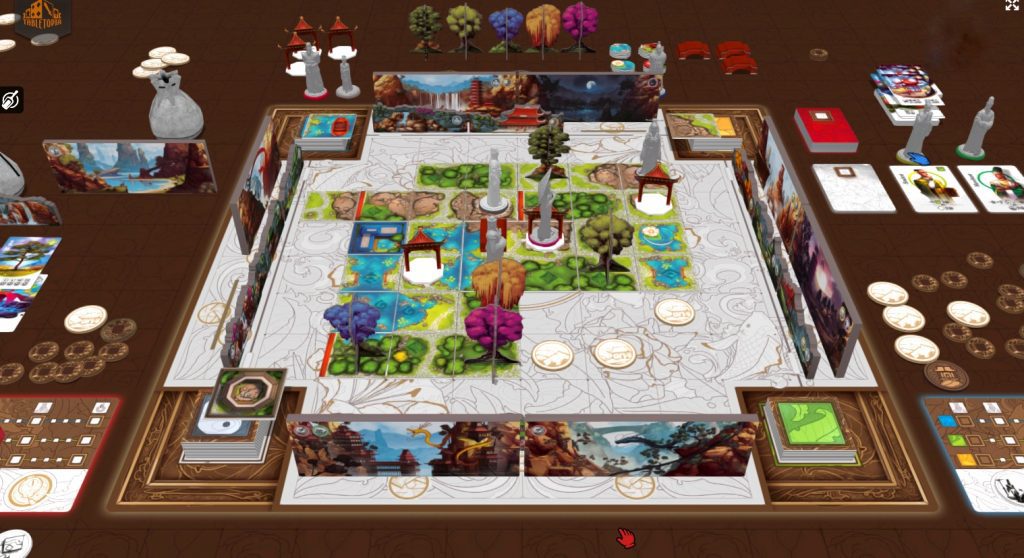
There is something so wonderful about how Tang Garden balances everything — and does it well. Whether it’s balancing which Garden and Landscape tiles or decorations to place, balancing your actions and ensuring you aren’t helping your opponents, or even deciding which (balanced) path to victory you’ll take, it all just works. And in a game where the theme is mostly pasted on — you’re building a garden in the time of the Tang dynasty — it’s this element of balance (at the heart of Chinese medicine) that feels the most thematic.
Tang Garden is my second favourite 2020 release I’ve played and if the delightful artwork doesn’t initially draw you in, then I hope its gameplay does. (You can even try Tang Garden on Tabletopia; just beware that there have been some changes, most notably to the player board.)
Thematic Music for Playing Tang Garden
There is a lovely playlist for Tang Garden that is available on Youtube, Google Play Music, Spotify, and Apple Music.
Since 2018 publisher Thundergryph Games has partnered with Trees for the Future to plant a tree for every game they sell — whether through Kickstarter, distribution, or direct sale. At the time of this review’s publication, more than 40,000 trees have been planted. Learn more at thundergryph.com/trees.


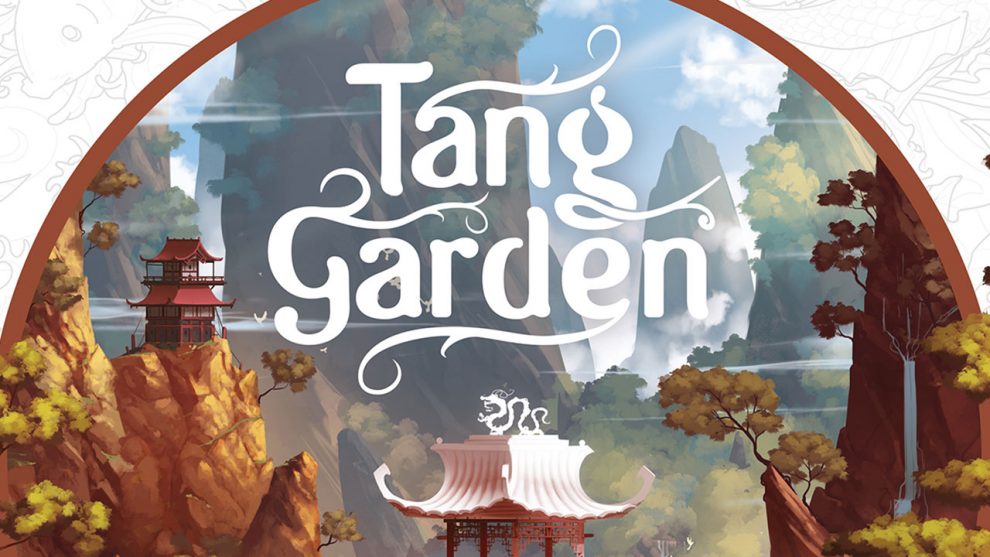









Add Comment